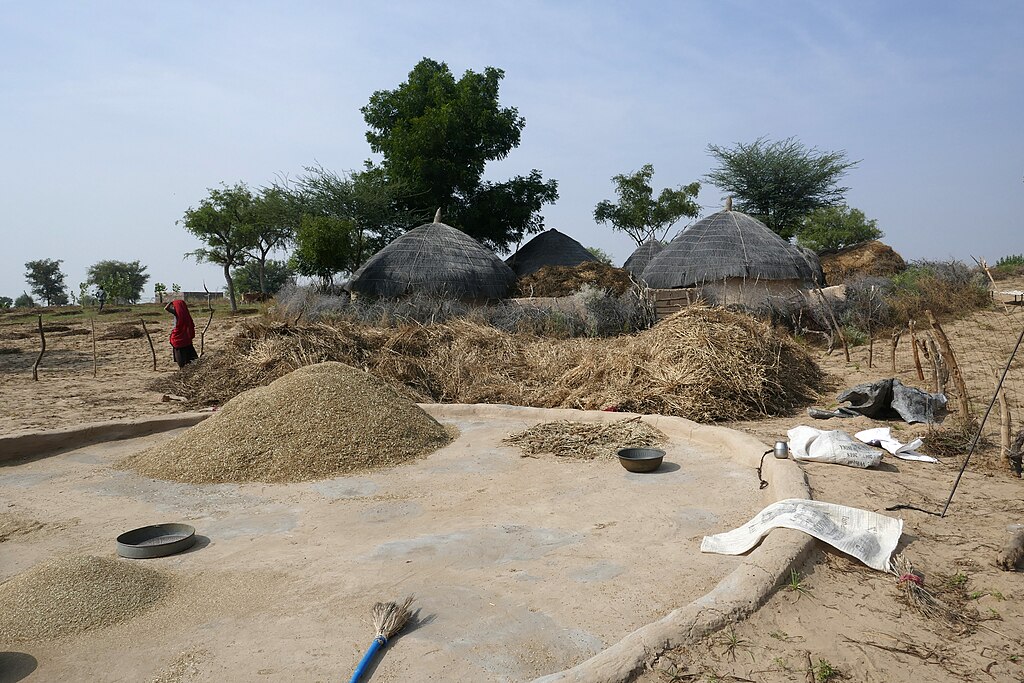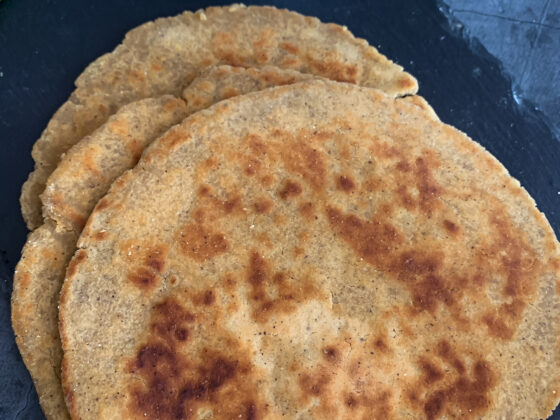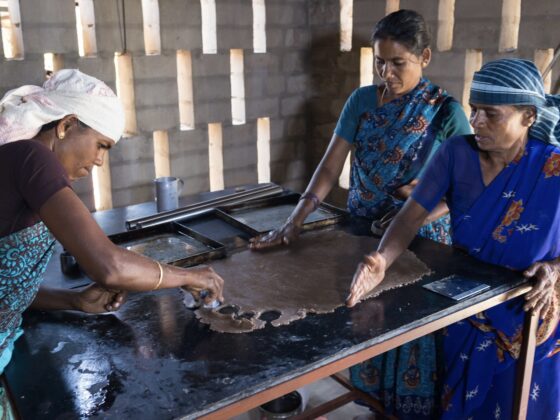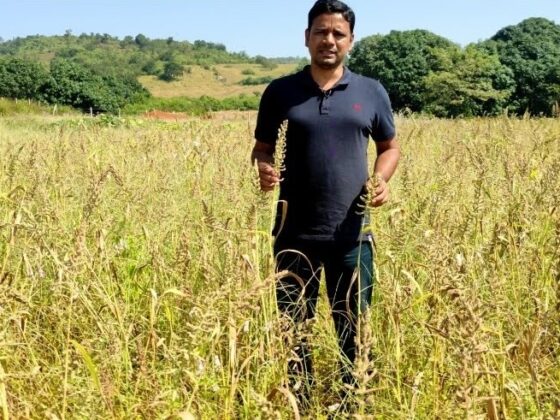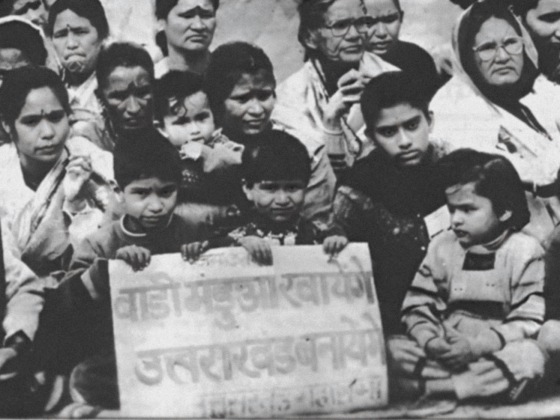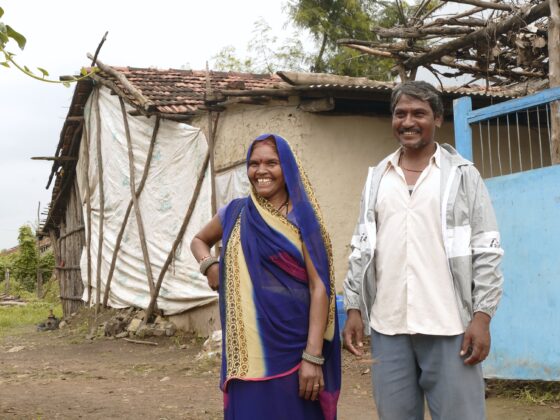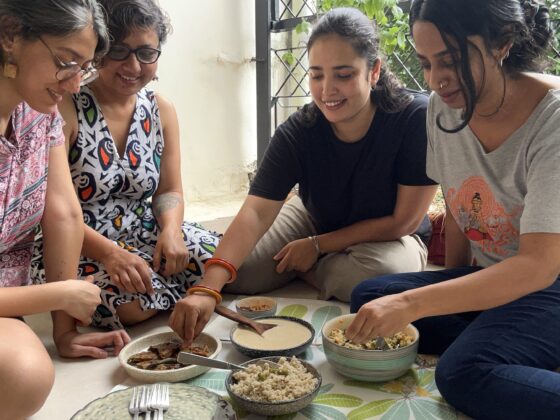How do tastes and desires, social hierarchies, access to resources, and public policy intersect to create complicated lived realities? Dr. Bhrigupati Singh explores some of these questions in the context of wheat and millets through his ethnographic research in Shahabad, Rajasthan.
The Indian sub-district of Shahabad, located in the forests of the southeastern tip of Rajasthan, is an area beset by droughts and food shortages, and home to the Sahariyas—former bonded labourers—officially classified as Rajasthan’s only “primitive tribe.” In trying to understand life despite deprivation and scarcity, Dr. Bhrigupati Singh seeks to convey the possibilities for abundance, challenging standard definitions of poverty, and reconsidering what quality of life really means.
In this excerpt, Dr. Singh explores a seemingly minor dietary shift that he began to pay attention to during his fieldwork, from millets to wheat, which was, he noticed, also a subterranean cause at the heart of the emerging water shortage in Shahabad. The everyday anxieties that existed around water, though not newsworthy, led him to ask something that has long interested anthropologists—what constitutes food, and what kind of food is indicative of hunger, or plenty?
Read an excerpt from Dr. Singh’s essay, Hunger and Thirst: Crises at Varying Thresholds of Life:

It was common knowledge, although it came to me late, that in these parts of northern and central India, wheat, seemingly a staple and ubiquitous grain at present, was an expensive, relatively rare and coveted food item until as recently as twenty years ago. Until a generation earlier, everyday diet was strongly differentiated across caste lines Shahabad. How would we understand this differentiation?
Scholarly writings on Hindu dietary practices have often focused on questions of vegetarianism, transactional purity (Dumont 1980, 130), and ascetic ideals of self-control (Khare 1992, 27). Slightly differently, I began to get interested in contrasts that surfaced even when a dietary norm was shared by low and high castes. These contrasts could not be arranged into hierarchies of “purity,” for instance, with vegetables. Middle castes such as Kiraads and Ahirs ate few or no vegetables. “Their staple was lapta and maheri [types of porridge] with curd or ghee [clarified butter], since they own so many cows,” was how Kailash, my closest friend in the area, described it. Kailash, in his late thirties, belonged to the low status (SC) Chamar caste, and worked for my host, NGO Sankalp.
Vegetables were more regularly consumed by the highest castes such as Brahmins and Baniyas and by the lowest, such as Sahariyas and Chamars. Qualitative differences between “high”- and “low”-caste diets were often stark, understood not in terms of purity, but between “coarser” and “finer” tastes. “Brahmins and Baniyas eat naram [fine] vegetables like palak [spinach], kaddu [pumpkin], and lockey [zucchini] with thin flatbreads [patli roti], not the tickker [coarse/thick/bumpkin] bread that everyone else eats,” Kailash added. At the coarsest end of the vegetable spectrum were the jungli bhaji (wild vegetables), some of which are now seen as primarily “distress” foods, indicative of hunger.
Qualitative differences between "high"- and "low"-caste diets were often stark, understood not in terms of purity, but between "coarser" and "finer" tastes.
In earlier generations, then, lower down in the caste hierarchy, diet became “coarser.” Then again, coarse is not a natural category. What we find coarse is a matter of habits and desires, which may also change. Until the late 1980s, the two main grain crops of Shahabad roughly followed an upreti (upland) and talheti (lowland) division of the region. The main crop upland, where the soil is loamy (maar), was jowar (sorghum/great millet). The main crop in the drier lowlands was bajra (pearl millet).
The different value of grains did not exactly mirror social hierarchies. Jowar, for instance, was a staple diet for high and low castes in the uplands. There were other hierarchies, though, even within households, that determined which grain one got to eat. For instance, Rajnish Parihar, in his late thirties from the high-status Rajput caste, described a childhood memory: “When I was a child, we only ate jowar. My village of Tejgarh is in the uplands. My elder brother had a problem digesting jowar, so my father used to buy a ten-kilogram bag of wheat for him every month. We younger ones would feel bad, like we were poorer. Rich relatives sometimes mock you, saying, ‘Unke tau jaape mei bhi gehu nahin milti [You aren’t served wheat even on the most auspicious occasions].’”

Millet was the coarser, everyday reality. Statistical studies of Rajasthan in the 1960s show bajra and jowar ranking highest in terms of regular consumption (Government of Rajasthan 1964, 34). In contrast, recent reports tell us that even as the per capita production of bajra in Rajasthan has drastically declined from eighty kilograms in 1970-71 to thirty kilograms in 2001-2, a major production surplus continues because the demand for the grain has fallen even more sharply, due to “changes in the consumption basket against coarse cereals generally and bajra in particular” (“Procurement Shift to Solve Bajra Row” 2003, 1). Policy discussions are under way to reposition bajra as animal feed (“Procurement Shift to Solve Bajra Row” 2003, 1). What we have, then, is the undramatic but drastic demotion of millets and the potential expansion of the category of distress foods.
The main technological enabler of this shift in diet and cropping patterns is the transnational Green Revolution, said to have begun in 1964-65 with the emergence of new agricultural technologies—most famously, the Mexican “dwarf wheat” high-yielding varieties of seeds, subsequently exported to many parts of the world, including India (Evenson 2004, 547). Half a century later, there are now well-established positions praising and criticizing the Green Revolution. The praise usually centers on the role of new agricultural technologies in addressing food shortages.

One of the first adopters of these new technologies in Shahabad was Mangilal Mehta, a middle-caste cultivator, now in his mid-sixties, who vividly remembered the transformation. “The first new seed was Sunehra 64 [the Mexican dwarf-wheat seed Sonora 64, translated into Hindi as “Sunehra ‘Golden’ 64”]. “I was the first to try it in my village. I bought the seed at a subsidy from our local agricultural-extension officer. The first time I tried it only on one bigha. I bought fifteen kilograms of seeds, twenty kilograms of DAP [phosphorus fertilizers], and twenty kilograms of urea [nitrogen fertilizers]. It yielded fifteen mann, thrice the amount from the previous year! I never went back to the old seeds.”
Mangilal was noncommittal when I asked about the criticisms of Green Revolution technologies that one occasionally overheard, in academic and everyday forms. “Some say that urea hardens the ground,” I said. “My field is still fertile,” Mangilal responded. I continued: “Others say that fertilizers cause diseases.” “Who knows? People used to fall sick earlier, too.” What concerned Mangilal more was an immediate threat—namely, the increasing lack of water. Millets are almost entirely rain-fed crops. Even in an irrigated field, millets need four or five times less water than wheat. Agricultural manuals tell us that the most crucial input for the heightened yields from high-yielding variety seeds is irrigation.
Even in an irrigated field, millets need four or five times less water than wheat.
Four to six irrigations are needed to obtain the optimum yield from wheat (ICAR 1976, 90). In Shahabad, this is known as the char paani (four waters) needed for wheat production. New technologies enable intensified water extraction. The Green Revolution was accompanied by the proliferation of water-extraction technologies, mostly known by their English names: the diesel-run “pump set” that “pulls” water from surface sources such as ponds and rivers, and bore wells and tube wells (the pataal tod kuan—a “netherworld-breaker” well) which burrow to extract directly from the groundwater—now a staple of many urban Indian households as well.
From zero in the 1960s, privately owned tube wells in rural Rajasthan at the time of my fieldwork had increased to 1.33 million (Birkenholtz 2005, 2). Even though it is an aspiration for many, Shahabad has a relatively meager 713 tube wells and 1,310 registered pump sets (Government of Rajasthan, 2003, 66). The reason for the comparatively low number of tube wells in Shahabad is the fact that the “netherworld-breaker” technology is relatively unsuccessful in the talheti lowland villages, since the bedrock below the soil is popra (shale), the irregular softness of which makes for poor groundwater-extraction potential.
As a result, most cultivators in the lowlands, like Mangilal, use a pump set if their land is close enough to an exploitable surface source of water such as a well, pond, or river. Mangilal shares a well with his two brothers, each of whom has installed a pump set in the well. Their village has a hundred families, all of whom have some form of mechanized access to water. Many in their village began to encounter a water shortage in the early 2000s. Because of these changes in water levels, in the last few years Mangilal has reduced his wheat cultivation to only two of his seven bighas, using the remaining land for soybeans, which require slightly less water. Because of the diminished water supply, his wheat yield has now waned to pre-Green Revolution levels.

Two itinerant fruit sellers arrived one night, looking for shelter in the home of a Sahariya cultivator, where I, too, happened to be spending the night. They were from Shivpuri, the district immediately north of Shahabad in Madhya Pradesh. They shared their worries: “In Shivpuri, there are bores going to five hundred feet, even one thousand feet, but finding no water. People are queuing up for a dish of water. Fights are breaking out daily. People are leaving in large numbers for cities. The government is seizing tube wells and forcing owners to provide fixed periods of service to the public. The owners are fighting back. They say that soon new laws will be passed, and no one will have water except for the government and rich people.” In comparison, “your Shahabad is blessed,” the fruit sellers added.
Tastes and values such as coarse and fine may seem like a minor footnote in the agrarian dramas of the twentieth century. However, I want to suggest that these more ephemeral values, not necessarily imposed on “indigenous” ways of life by policy fiat or economic incentives, are also involved in these processes of desertification.
Consider again the empowering aspect of wheat as the food item through which hunger is overcome. Most Sahariyas and other castes in Shahabad ate wheat only a few times a year until even twenty years ago—for instance, bonded laborers who received a fistful of wheat during a festival, or, as we saw with Rajnish above, even the high-caste Rajput family in which the younger brothers would look on jealously at their elder brother’s “richer” plate. Now the poor eat wheat every day, would they (or “we”) agree to restore millets to our diets? This depends on the value ascribed to millets, values that might be changeable.
Accepting these tectonic movements, we might instead focus on how life (understood here as a sense of vitality and plenitude) waxes and wanes. What may have been life giving at a certain point—say, a growth spurt in wheat—may become life denying at a later point, in creating a water scarcity. Millets, as we see which sustained life for centuries, were demoted. Perhaps at a later stage, soon enough, they may have to ascend again. The critical question is how to sense and participate in these waxing and waning movements at a given juncture.
Now the poor eat wheat every day, Would they (or "we") agree to restore millets to our diets? This depends on the value ascribed to millets, values that might be changeable.
By whose logic or feeling did millets come to be demoted and classified as “coarse” or “inferior”? Was it government policy, or local tastes, or both? British colonial archives, particularly inquiries into “famine foods,” reveal strong hierarchies and value-laden preferences in the “objective” classification of vegetables and grain, with millets consistently at a lower rank. The problem here, as I see it, arises with the gradual expansion of the category of distress foods, through state dictates and social values. Our habits may shift, creating a crisis out of what was formerly ordinary. Millets themselves, as we saw, are not a unified category. These hierarchies are currently in the process of a seismic shift, with an unprecedented and harmful ascent of wheat to the detriment of other grains.
In examining this shift in Shahabad, we see that tastes are not entirely dictated by governmental policy. Policies in turn may express social prejudices and values. Even lower in value than jowar and bajra were other millets that have entirely disappeared from the area, kodo and raali (“small” millets common in various parts of Asia and Africa) [Seetharam et al. 1986, 25]. Lower-caste men would often tell me their memories of small millets from earlier decades. “We grew it in the dhaanda [dry land]. My father liked it, but I just couldn’t eat it. It was too khiss-khissi [dry/coarse/hard to swallow],” Kailash said. The word khiss-khissi (“coarse”) expressed a visceral revulsion that was not necessarily ideological. One may gradually learn or unlearn a “traditional” diet.
Is it possible to eat without injuring life? The question is what kind of injury may be preventable. When I spoke enthusiastically about readopting millets, I was warned by some in Shahabad. “You’ll fall sick if you eat it every day.” They added informatively, “I can’t shit if I eat bajra for three days in a row.” If millets are to make a return, perhaps they will have to reemerge as a more “cultivated” taste, rearranged in hierarchy and value, and mode of preparation. Some with more radical political tastes may scoff at such minor “lifestyle” changes. On a larger scale though a sympathetic reinvitation of millets into global diets may have more beneficial environmental and social consequences than many of the more newsworthy revolutions of the twentieth century. Simply put, if consumed on a large enough scale, say, by the upper and middle classes worldwide, even once every three days, millets have the potential to gradually regenerate the water table, perhaps preventing the water wars of the future.
This is an excerpt from ‘Living and Dying in the Contemporary World’, edited by Veena Das and Clara Han, and published in 2015 (University of California Press). Excerpted with permission from the author and the University of California Press.
Footnotes
Birkenholtz, T. 2005. “Tube-Well Institutions in Rajasthan, India.” Paper presented at the Fifth International Conference on Rajasthan, Institute of Rajasthan Studies, Jaipur, December 29-31.
Dumont L. 1980. Homo Hierarchicus: The Caste System and Its Implications, Chicago: University of Chicago Press.
Evenson, R.E. 2004. “Food and Population: D. Gale Johnson and the Green Revolution.” Economic Development and Cultural Change 52:543-69.
Government of Rajasthan. 1964. Recent Developments in Rajasthan. Symposium on Problems of Indian Arid Zones. Jodhpur: Ministry of Food and Agriculture and Central Arid Zone Research Institute.
Government of Rajasthan. 2003. District-Wise Statistical Outline, Baran District, Jaipur: Department of Economics and Statistics.
ICAR (Indian Council for Agricultural Research). 1976. Wheat Research in India. 1966-1976. New Delhi.
Khare. R.S., 1992. The Eternal Food: Gastronomic Ideas and Experiences of Hindus and Buddhists. Albany, NY: SUNY Press.
“Procurement Shift to Solve Bajra Row.” 2003. Hindu, October 16.
Seetharam, A., K. W. Riley, and G. Harinarayana, eds. 1986. Small Millets in Global Agriculture. New Delhi: Oxford & IBH.
Dr. Bhrigupati Singh is an Associate Professor of Anthropology and Sociology at Ashoka University, Visiting Associate Professor of Psychiatry at Brown University, and a Research Fellow at the Carney Institute for Brain Science.

This article is part of the Millet Revival Project, The Locavore’s modest attempt to demystify cooking with millets, and learn the impact that it has on our ecology. This initiative, in association with Rainmatter Foundation, aims to facilitate the gradual incorporation of millets into our diets, as well as create a space for meaningful conversation and engagement so that we can tap into the resilience of millets while also rediscovering its taste.

Rainmatter Foundation is a non-profit organisation that supports organisations and projects for climate action, a healthier environment, and livelihoods associated with them. The foundation and The Locavore have co-created this Millet Revival Project for a millet-climate outreach campaign for urban consumers. To learn more about the foundation and the other organisations they support, click here.
